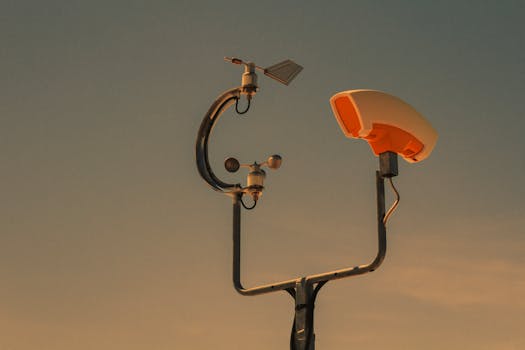
How Satellites Monitor Climate Change and Environmental Shifts is a vital topic in today’s world. Climate change and environmental shifts are two of the most pressing issues of our time, with far-reaching consequences for our planet and its inhabitants. To better understand and address these challenges, scientists and policymakers rely on a network of satellites orbiting the Earth, providing vital data on the state of our environment. In this article, we will explore the role of satellites in monitoring climate change and environmental shifts, and how this information is used to inform decision-making and drive action.
Satellites have been monitoring the Earth’s environment for decades, with the first Earth observation satellite, TIROS-1, launched in 1960. Since then, the number and capabilities of these satellites have grown exponentially, with modern satellites equipped with advanced sensors and instruments to collect data on a wide range of environmental parameters. These include temperature, sea level rise, ice sheet melting, deforestation, and ocean health, among others. By analyzing this data, scientists can identify trends and patterns that help us understand the causes and consequences of climate change and environmental shifts.
One of the key areas where satellites have made a significant impact is in the monitoring of greenhouse gas emissions. Satellites such as the Orbiting Carbon Observatory (OCO-2) and the Global Carbon Project’s satellite fleet use spectrometers to measure the concentration of carbon dioxide and other greenhouse gases in the atmosphere. This data is essential for understanding the sources and sinks of these gases, and for developing strategies to reduce emissions and mitigate the impacts of climate change. For example, satellite data has shown that the Amazon rainforest is a significant carbon sink, absorbing more carbon dioxide than previously thought, while also highlighting the impact of deforestation on greenhouse gas emissions.
In addition to monitoring greenhouse gas emissions, satellites are also used to track changes in the Earth’s climate system. Satellites such as the NASA’s Terra and Aqua satellites use multispectral and hyperspectral sensors to collect data on sea surface temperature, sea level rise, and ice sheet melting. This data is used to study the impacts of climate change on ocean currents, sea level rise, and ice sheet dynamics, and to improve climate models and predict future changes. For instance, satellite data has shown that the Arctic ice cap has been shrinking at an alarming rate, with significant implications for global sea levels and ocean circulation patterns.
Satellites also play a critical role in monitoring environmental shifts, such as deforestation and land degradation. Satellites such as the Landsat 8 and Sentinel-2 use high-resolution multispectral sensors to collect data on land cover and land use changes. This data is used to study the impacts of deforestation and land degradation on biodiversity, soil health, and water cycles, and to develop strategies for sustainable land use and conservation. For example, satellite data has shown that the rate of deforestation in the Amazon rainforest has been increasing in recent years, with significant implications for biodiversity and ecosystem services.
In conclusion, How Satellites Monitor Climate Change and Environmental Shifts is a critical component of our efforts to address these global challenges. By providing vital data on the state of our environment, satellites help us understand the causes and consequences of climate change and environmental shifts, and inform decision-making and drive action to mitigate these impacts. As the number and capabilities of satellites continue to grow, we can expect to see even more detailed and accurate data on the state of our environment, and to develop more effective strategies for sustainable development and environmental conservation.
Furthermore, the use of satellites in monitoring climate change and environmental shifts has numerous benefits, including improved accuracy and precision, increased coverage and frequency of data collection, and enhanced coordination and cooperation among governments, international organizations, and civil society. Additionally, satellite data can be used to support climate change adaptation and resilience efforts, such as early warning systems for extreme weather events, and to inform decision-making on climate change mitigation and environmental conservation.
Moreover, satellites have also been used to monitor and track the impacts of climate change on human populations, including migration patterns, food security, and human health. For instance, satellite data has been used to study the impacts of drought on agricultural production and food security, and to develop early warning systems for heatwaves and other extreme weather events. This information is critical for developing effective strategies to support climate change adaptation and resilience efforts, and to protect the most vulnerable populations from the impacts of climate change.
Overall, the role of satellites in monitoring climate change and environmental shifts is a critical one, and their contributions will only continue to grow in importance in the coming years. As we move forward, it is essential that we continue to invest in satellite technology and Earth observation capabilities, and to develop more effective strategies for using satellite data to inform decision-making and drive action on climate change and environmental conservation.
Finally, it is worth noting that the use of satellites in monitoring climate change and environmental shifts is not without its challenges and limitations. For example, satellite data can be affected by atmospheric interference, instrument calibration issues, and data gaps, which can impact the accuracy and precision of the data. Additionally, the analysis and interpretation of satellite data require specialized skills and expertise, and can be time-consuming and resource-intensive. However, these challenges can be addressed through continued investment in satellite technology and Earth observation capabilities, and through the development of more effective strategies for using satellite data to inform decision-making and drive action on climate change and environmental conservation.

